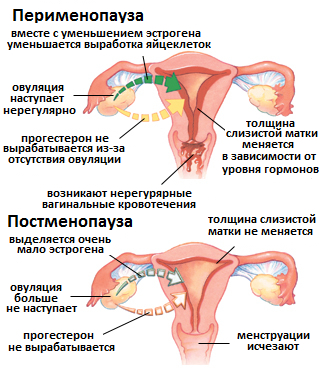Although the clinical manifestations of menopause can cause severe discomfort to a woman, many clinicians are wary of prescribing hormone therapy because of the potential for side effects.
However, the task of a specialist is to weigh all the risks and make this difficult period in a woman's life as comfortable as possible. Read on estet-portal.com about the indications, contraindications and main features of hormonal therapy in menopause, as well as additional methods for correcting discomfort during menopause.
Clinical picture of vasomotor manifestations of menopause
Spontaneous menopause, the permanent cessation of menstruation due to loss of ovarian function, occurs on average at age 51-52. At the same time, vasomotor symptoms are its most unpleasant manifestations, and the most common reason why women seek medical help during this period.
Often described by women as hot flashes or night sweats, vasomotor symptoms are accompanied by a sudden sensation of heat in the face, neck and chest, redness, chills, restlessness, sleep disturbance and palpitations.
During hot flashes, skin temperature rises due to peripheral vasodilation, especially in the fingers and toes.
Along with peripheral vasodilation and sweating, heart rate increases by 7-15 beats per minute. It may take more than half an hour for the woman to return to normal.
Mechanism of development and symptoms of menopause in women
Pathophysiology of vasomotor manifestations during menopause

The pathophysiology of vasomotor symptoms during menopause is not fully understood. However, these clinical manifestations are known to be caused by:
• a decrease in estrogen levels, which leads to a drop in core body temperature;
• pulsatile secretion of luteinizing hormone from the pituitary gland;
• a decrease in the concentration of endorphins in the hypothalamus;
• increased release of norepinephrine, serotonin and other neuroregulators.
These neurotransmitters lower the setpoint in the thermoregulatory core of the hypothalamus, causing inappropriate heat loss.
Systemic hormone therapy for vasomotor symptoms of menopause
Systemic estrogen therapy is indicated for the treatment of moderate to severe vasomotor symptoms of menopause.
This treatment is contraindicated if:
• unexplained vaginal bleeding;
• liver dysfunction;
• history of deep venous thrombosis or pulmonary embolism;
• blood clotting disorders or thrombophilia;
• estrogen-dependent neoplasms;
• hypersensitivity to hormone therapy;
• history of coronary heart disease, stroke or transient ischemic attack.
Also do not recommend systemic hormonal therapy for high triglycerides, gallbladder disease, increased risk of breast cancer.Among the drugs, the most effective today are combined estrogen-progestin drugs, natural and conjugated estrogens, natural and synthetic progestogens.
Read the latest articles in Telegram!
Additional methods for the correction of vasomotor symptoms during menopauseMeasures to manage vasomotor symptoms include maintaining a cool temperature, avoiding smoking, alcohol, caffeine and spicy foods, and a diet low in salt and fast carbohydrates.
Numerous studies have shown the ineffectiveness of homeopathic remedies, phytoestrogens and omega fatty acids in the treatment of vasomotor manifestations of menopause.
Non-hormonal drugs used to treat vasomotor symptoms of menopause include selective serotonin reuptake inhibitors (more commonly used to treat depression) and anticonvulsants (more commonly used to treat neuropathic pain).
Thus, depending on the severity of the manifestations of vasomotor symptoms, the doctor determines whether the patient needs systemic hormonal therapy, or, to improve her condition, it is enough to correct her diet and lifestyle.
Read also: Urinary symptom of menopause: a new term in modern gynecology







Add a comment